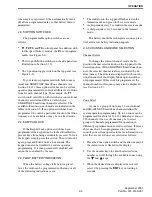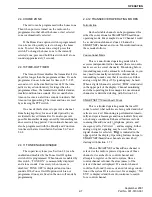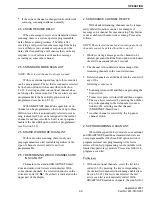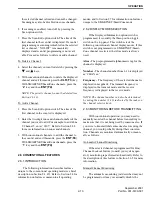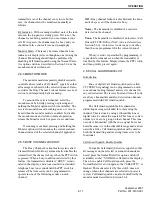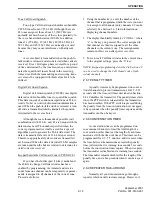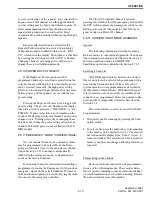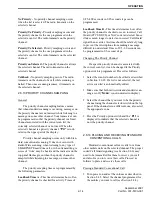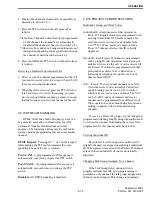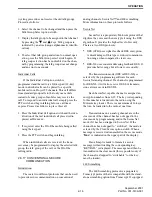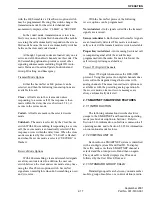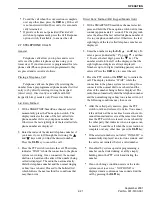
OPERATION
2-7
September 2001
Part No. 001-5100-001
2.4.9 HOME ZONE
The radio can be programmed with a home zone.
Then when power is turned on, the radio can be
programmed so that either the home or last selected
zone is automatically selected.
If the Home Zone option switch is programmed,
it can be used to quickly select or change the home
zone. To select the home zone, simply press this
switch. To change the home zone to the currently
selected zone, press and hold this switch until a tone
sounds (approximately 1 second).
2.4.10 TIME-OUT TIMER
The time-out timer disables the transmitter if it is
keyed for longer than the programmed time. It can be
programmed on each channel for times of 15 - 225
seconds or it can be disabled (not used). If the trans-
mitter is keyed continuously for longer than the
programmed time, the transmitter is disabled and an
invalid condition tone sounds. Five seconds before
time-out occurs, an alert tone sounds to indicate that
time-out is approaching. The timer and tone are reset
by releasing the PTT switch.
One use of this feature is to prevent a channel
from being kept busy for an extended period by an
accidentally keyed transmitter. It can also prevent
possible transmitter damage caused by transmitting for
an excessively long period. Conventional channels can
also be programmed with the Penalty and Conversa-
tion timers that are described in Sections 2.6.7 and
2.6.8.
2.4.11 TONE ENABLE/DISABLE
The supervisory tones (see Section 2.8) can be
enabled and disabled by the Tones On-Off option
switch if it is programmed. When tones are enabled by
this switch, “TONE ON” is momentarily displayed
and a tone sounds. Conversely, when tones are
disabled, “TONE OFF” is displayed and no tone
sounds. If the Tones On-Off option switch is not
programmed, tones are fixed in the on or off mode by
programming.
2.4.12 TRANSCEIVER OPERATING MODES
Introduction
Each selectable channel can be programmed for
either the conventional or SMARTNET/SmartZone
operating mode. For example, Zone 1/Channel 1 could
be a conventional channel, Zone 1/Channel 2 a
SMARTNET channel, and so on. More information on
these modes follows.
Conventional Mode
This is a non-trunked operating mode which
accesses independent radio channels (there is no auto-
matic access to several channels). Monitoring before
transmitting may not be automatic in this mode, so you
may need to manually monitor the channel before
transmitting to make sure that it is not in use. Either
analog or digital (Project 25) signaling may be used.
When a digital channel is selected, “
DIG
” is indicated
in the upper part of the display. Channel monitoring
and other operating features unique to conventional
channels are described starting with Section 2.6.1.
SMARTNET™/SmartZone® Mode
This is a trunked operating mode that uses ID
codes to select what mobiles are being called and what
calls are received. Monitoring is performed automati-
cally and special messages and tones indicate busy and
out-of-range conditions. Enhanced features include
roaming (SmartZone only), telephone, private, and
emergency calls, Call Alert
™
, and messaging. Either
analog or digital signaling may be used. When a
digital channel is selected, “
Dig
” is indicated in the
upper part of the display. Operating features unique to
SMARTNET/SmartZone channels are described
starting with Section 2.7.1.
When a SMARTNET or SmartZone channel is
selected or the radio is powered up on one of those
channels, it searches for a control channel and
attempts to register on the radio system. Once a
control channel is found, the alias (name) of the
selected channel is displayed. If a control channel
could not be found (because of an out of range condi-
tion or the system ID is not correct, for example), “NO
SYS” is displayed and the radio continues to search
for a control channel.














